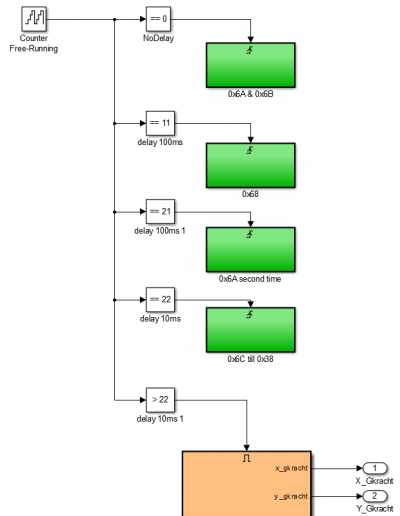HANcoder/Training Material/MPU6500
Contents
MPU6500 3 Axis gyro and 3 axis accelerometer
The MPU6500 has a programmable scale for both the gyroscope and the accelerometer. It can measure angular rates up to 2000°/sec and up to 16G of acceleration. The sensor can be configured and read by using the SPI bus.
Connecting the MPU6500
First the MPU6500 must be soldered on the prototype PCB. It is wise to solder some female headers onto the PCB and male headers onto the MPU6500 so it can be replaced when broken. Make sure it is mounted ruggedly to make sure the sensor won't measure movements of the sensor relative to the board. Next the pins must be connected to the E407 pins, see the connection diagram below.
SPI control in Simulink
As mentioned before the communication with the sensor is done via SPI. First the SPI Master Init block is used to initialize the SPI system. Channel 1 is chosen with a baud rate of 656.25kHz because the datasheet states that the maximum SPI clock frequency is 1Mhz. The polarity is chosen to be 'Idle low' and phase 'Sample bit on 1st clock edge', these settings also come from the datasheet of the MPU6500.

Configuring the MPU6500
The MPU6500 needs to be configured, because the chip needs some time to process the configurations some delay has to be added between sending the bytes. This is done with the use of a free running counter. The counter increases every 10ms so by checking the output of the counter a delay can be generated. See the Simulink model screenshot below:

First, when the counter value is 0, register 0x6A and 0x6B are written. The next register, 0x68, is written when the counter value is 11 which is a delay of 110ms. After all the configuration subsystems (green blocks) are executed, reading the sensor signals begins in the orange subsystem. Let's look inside one of the configuration subsystems:
![]()
Here two registers are written using 4 transfers of a byte. The first bit of the first byte indicates if it is a read (1) or a write (0) action. The following 7 bits are the address bits of the register. After this the value can be send to the MPU6500. A value of 0x9F is send, this means: I2C disable, FIFO disable, FIFO reset, etc. Immediately after the next register is written. SPI works with a slave select pin, this pin is pulled low before the transfer so the slave knows the data is for him. The slave select pin is kept low until the data to the second register has been successfully send.
![]()